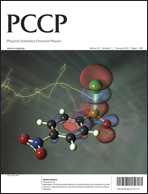Oligomers of Diphenylalanine Interrogated by Cold Ion Spectroscopy and Neural Network-based Conformational Search
IF 2.9
3区 化学
Q3 CHEMISTRY, PHYSICAL
引用次数: 0
Abstract
Diphenylalanine (Phe2) is the primary building block of many self-assembling nanostructures that are important in biology and material science. Understanding the detailed mechanism of their formation requires knowledge of the structural motives the smallest oligomers attain at the very first steps of the process. Here we, first, employ high-resolution mass spectrometry to assign protonated Phe2 and its 2- to 13-unit oligomers formed in the gas phase from solution by electrospray ionization and then use cold ion spectroscopy to record their UV and, for monomer, dimer and hexamer, IR spectra. UV spectroscopy suggests the likely lack of specific strong proton- interactions in the oligomers larger than octamer, implying their certain structural stabilization. The IR spectroscopy and quantum chemical calculations, enhanced by neural network-based conformational search, jointly have determined the lowest-energy structures of the Phe2 monomer and dimer.通过冷离子光谱和基于神经网络的构象搜索对二苯丙氨酸的低聚物进行探测
二苯丙氨酸(Phe2)是许多自组装纳米结构的主要构件,在生物学和材料科学领域具有重要意义。要了解其形成的详细机制,就必须了解最小的低聚物在该过程的最初步骤中获得的结构动机。在这里,我们首先利用高分辨率质谱法分配质子化的 Phe2 及其在气相中通过电喷雾离子化从溶液中形成的 2 至 13 个单位的低聚物,然后利用冷离子光谱法记录它们的紫外光谱,以及单体、二聚体和六聚体的红外光谱。紫外光谱表明,大于八聚体的低聚物可能缺乏特定的强质子,这意味着它们具有一定的结构稳定性。红外光谱和量子化学计算通过基于神经网络的构象搜索共同确定了 Phe2 单体和二聚体的最低能结构。
本文章由计算机程序翻译,如有差异,请以英文原文为准。
求助全文
约1分钟内获得全文
求助全文
来源期刊

Physical Chemistry Chemical Physics
化学-物理:原子、分子和化学物理
CiteScore
5.50
自引率
9.10%
发文量
2675
审稿时长
2.0 months
期刊介绍:
Physical Chemistry Chemical Physics (PCCP) is an international journal co-owned by 19 physical chemistry and physics societies from around the world. This journal publishes original, cutting-edge research in physical chemistry, chemical physics and biophysical chemistry. To be suitable for publication in PCCP, articles must include significant innovation and/or insight into physical chemistry; this is the most important criterion that reviewers and Editors will judge against when evaluating submissions.
The journal has a broad scope and welcomes contributions spanning experiment, theory, computation and data science. Topical coverage includes spectroscopy, dynamics, kinetics, statistical mechanics, thermodynamics, electrochemistry, catalysis, surface science, quantum mechanics, quantum computing and machine learning. Interdisciplinary research areas such as polymers and soft matter, materials, nanoscience, energy, surfaces/interfaces, and biophysical chemistry are welcomed if they demonstrate significant innovation and/or insight into physical chemistry. Joined experimental/theoretical studies are particularly appreciated when complementary and based on up-to-date approaches.
 求助内容:
求助内容: 应助结果提醒方式:
应助结果提醒方式:


